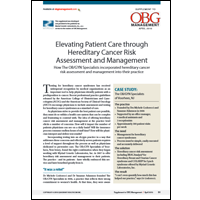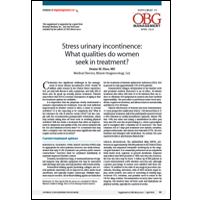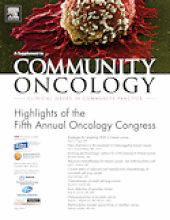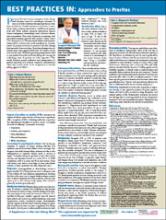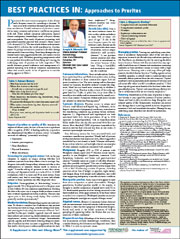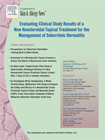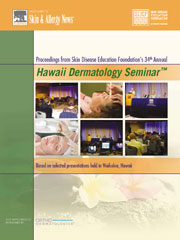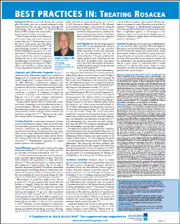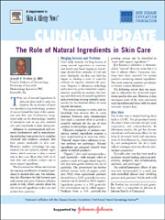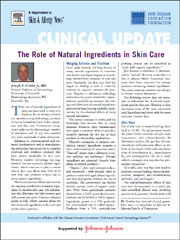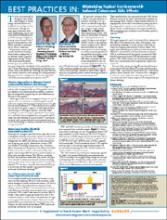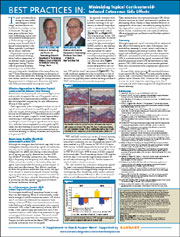User login
Fluids and electrolyte management
Introduction
Many infants and children are hospitalized in the United States each year for fluid and electrolyte disorders. Dehydration from gastroenteritis alone accounts for more than 200,000 pediatric hospitalizations each year. An understanding of pediatric fluid therapy is one of the most important advances of pediatric medicine and a cornerstone of current inpatient pediatric practice. Although the majority of previously healthy hospitalized children can compensate for errors in calculations of fluid therapy, mistakes, even in healthy children admitted for minor illnesses, can have devastating outcomes. Patients with underlying disease processes are at even greater risk for adverse outcomes if fluids and electrolytes are not meticulously managed. Pediatric hospitalists should be experts at managing frequently encountered fluid and electrolyte abnormalities.
Knowledge
Pediatric hospitalists should be able to:
Discuss the physiology of fluid and electrolyte homeostasis and the changes that occur with growth and development.
Discuss how maintenance fluid calculations are based upon water and electrolyte homeostasis using various methods such as the body surface area or Holliday Segar methods. Describe the methods used for calculation of excessive fluid losses due to causes such as diarrhea, increased ostomy output, burns, and vomiting; identify the best fluid replacement type for each.
Describe common errors in clinical estimations of dehydration and fluid and electrolyte requirements.
Explain the rationale, indications and contraindications for oral rehydration, including the correct glucose and electrolyte composition and technique for administration.
Discuss the benefits of and barriers to use of nasogastric tubes for administering enteral fluids.
Discuss the options and indications for different methods of parenteral fluid administration, including intravenous, intraosseous, and subcutaneous.
Review the indications for administering a parenteral fluid bolus for resuscitation and explain the rationale for the use of isotonic fluids for rehydration.
Discuss the benefits and risks of repeated lab testing and intravenous access placement, including cost, pain, effect on clinical management, family/caregiver perceptions, staff time, and others.
Compare and contrast true hyponatremia with pseudohyponatremia and give examples of conditions in which these exist.
List differential diagnoses for hyponatremia and hypernatremia.
Summarize the management of hypo‐ and hypernatremia, attending to duration of corrective therapy and potential complications during correction.
Distinguish between hyperkalemia and pseudohyperkalemia and give examples of the conditions in which these exist.
List differential diagnoses for hypokalemia and hyperkalemia.
Distinguish hypocalcemia from pseudohypocalcemia and give examples of the conditions in which these exist.
Discuss the interaction of fluid and electrolytes with acid/base balance.
Describe common acid/base disturbances that accompany the most frequently encountered causes of fluid deficit and give examples of exacerbating issues such as underlying co‐morbidity and use of over‐the‐counter medications.
Skills
Pediatric hospitalists should be able to:
Accurately calculate maintenance fluid and electrolyte requirements for hospitalized infants and children.
Promptly adjust maintenance fluids for increased insensible losses and ongoing fluid and electrolyte needs.
Estimate the degree of dehydration for children of various ages based upon clinical symptoms and signs.
Recognize common presenting signs and symptoms in infants and children that are associated with an excess or deficit of each common electrolyte and glucose.
Correctly estimate osmolar disturbance by interpreting electrolyte, glucose and blood urea nitrogen results.
Calculate and administer an isotonic fluid bolus correctly when indicated.
Obtain intravenous or intraosseous access in moderate to severely dehydrated patients.
Assess the success of fluid resuscitation by interpreting clinical change and laboratory values.
Calculate and administer maintenance and deficit fluid replacement for isotonic, hypertonic, and hypotonic dehydration.
Interpret urine and serum electrolytes and osmolality, as well as fluid status (hypo, hyper or isovolemic), to determine the etiology for hyponatremia or hypernatremia.
Correct hyponatremia using appropriate replacement or restriction of fluids, sodium chloride, and medications depending upon the diagnosis.
Correct hypernatremia using an appropriate electrolyte composition and rate of fluid replacement, as well as medications depending upon the diagnosis.
Correct hypoglycemia using an appropriate replacement solution.
Interpret EKG findings in the context of specific electrolyte abnormalities.
Safely prescribe electrolyte replacement therapy and institute proper monitoring for arrhythmias.
Correct symptomatic hyperkalemia using a combination of therapies to stabilize cardiac conduction, redistribute potassium to the intracellular space and remove it from the body.
Attitudes
Pediatric hospitalists should be able to:
Consult pediatric subspecialists appropriately to expedite the diagnosis and management of serious electrolyte disorders.
Recognize the benefits of oral rehydration and advocate for its use when indicated and clinically appropriate.
Coordinate subspecialty and primary care follow up for patients with persistent disturbances at discharge as appropriate.
Consider cost‐effectiveness, pain, and patient safety when creating plans for the treatment of fluid deficits.
Systems Organization and Improvement
In order to improve efficiency and quality within their organizations, pediatric hospitalists should:
Lead, coordinate or participate in plans to develop institutional policies to safely monitor and administer fluids and electrolytes.
Work collaboratively with others such as surgeons, intensivists, and advanced practice nurses to establish venous access when needed.
Lead, coordinate or participate in developing guidelines for the treatment of fluid and electrolyte abnormalities in the hospital and community.
Introduction
Many infants and children are hospitalized in the United States each year for fluid and electrolyte disorders. Dehydration from gastroenteritis alone accounts for more than 200,000 pediatric hospitalizations each year. An understanding of pediatric fluid therapy is one of the most important advances of pediatric medicine and a cornerstone of current inpatient pediatric practice. Although the majority of previously healthy hospitalized children can compensate for errors in calculations of fluid therapy, mistakes, even in healthy children admitted for minor illnesses, can have devastating outcomes. Patients with underlying disease processes are at even greater risk for adverse outcomes if fluids and electrolytes are not meticulously managed. Pediatric hospitalists should be experts at managing frequently encountered fluid and electrolyte abnormalities.
Knowledge
Pediatric hospitalists should be able to:
Discuss the physiology of fluid and electrolyte homeostasis and the changes that occur with growth and development.
Discuss how maintenance fluid calculations are based upon water and electrolyte homeostasis using various methods such as the body surface area or Holliday Segar methods. Describe the methods used for calculation of excessive fluid losses due to causes such as diarrhea, increased ostomy output, burns, and vomiting; identify the best fluid replacement type for each.
Describe common errors in clinical estimations of dehydration and fluid and electrolyte requirements.
Explain the rationale, indications and contraindications for oral rehydration, including the correct glucose and electrolyte composition and technique for administration.
Discuss the benefits of and barriers to use of nasogastric tubes for administering enteral fluids.
Discuss the options and indications for different methods of parenteral fluid administration, including intravenous, intraosseous, and subcutaneous.
Review the indications for administering a parenteral fluid bolus for resuscitation and explain the rationale for the use of isotonic fluids for rehydration.
Discuss the benefits and risks of repeated lab testing and intravenous access placement, including cost, pain, effect on clinical management, family/caregiver perceptions, staff time, and others.
Compare and contrast true hyponatremia with pseudohyponatremia and give examples of conditions in which these exist.
List differential diagnoses for hyponatremia and hypernatremia.
Summarize the management of hypo‐ and hypernatremia, attending to duration of corrective therapy and potential complications during correction.
Distinguish between hyperkalemia and pseudohyperkalemia and give examples of the conditions in which these exist.
List differential diagnoses for hypokalemia and hyperkalemia.
Distinguish hypocalcemia from pseudohypocalcemia and give examples of the conditions in which these exist.
Discuss the interaction of fluid and electrolytes with acid/base balance.
Describe common acid/base disturbances that accompany the most frequently encountered causes of fluid deficit and give examples of exacerbating issues such as underlying co‐morbidity and use of over‐the‐counter medications.
Skills
Pediatric hospitalists should be able to:
Accurately calculate maintenance fluid and electrolyte requirements for hospitalized infants and children.
Promptly adjust maintenance fluids for increased insensible losses and ongoing fluid and electrolyte needs.
Estimate the degree of dehydration for children of various ages based upon clinical symptoms and signs.
Recognize common presenting signs and symptoms in infants and children that are associated with an excess or deficit of each common electrolyte and glucose.
Correctly estimate osmolar disturbance by interpreting electrolyte, glucose and blood urea nitrogen results.
Calculate and administer an isotonic fluid bolus correctly when indicated.
Obtain intravenous or intraosseous access in moderate to severely dehydrated patients.
Assess the success of fluid resuscitation by interpreting clinical change and laboratory values.
Calculate and administer maintenance and deficit fluid replacement for isotonic, hypertonic, and hypotonic dehydration.
Interpret urine and serum electrolytes and osmolality, as well as fluid status (hypo, hyper or isovolemic), to determine the etiology for hyponatremia or hypernatremia.
Correct hyponatremia using appropriate replacement or restriction of fluids, sodium chloride, and medications depending upon the diagnosis.
Correct hypernatremia using an appropriate electrolyte composition and rate of fluid replacement, as well as medications depending upon the diagnosis.
Correct hypoglycemia using an appropriate replacement solution.
Interpret EKG findings in the context of specific electrolyte abnormalities.
Safely prescribe electrolyte replacement therapy and institute proper monitoring for arrhythmias.
Correct symptomatic hyperkalemia using a combination of therapies to stabilize cardiac conduction, redistribute potassium to the intracellular space and remove it from the body.
Attitudes
Pediatric hospitalists should be able to:
Consult pediatric subspecialists appropriately to expedite the diagnosis and management of serious electrolyte disorders.
Recognize the benefits of oral rehydration and advocate for its use when indicated and clinically appropriate.
Coordinate subspecialty and primary care follow up for patients with persistent disturbances at discharge as appropriate.
Consider cost‐effectiveness, pain, and patient safety when creating plans for the treatment of fluid deficits.
Systems Organization and Improvement
In order to improve efficiency and quality within their organizations, pediatric hospitalists should:
Lead, coordinate or participate in plans to develop institutional policies to safely monitor and administer fluids and electrolytes.
Work collaboratively with others such as surgeons, intensivists, and advanced practice nurses to establish venous access when needed.
Lead, coordinate or participate in developing guidelines for the treatment of fluid and electrolyte abnormalities in the hospital and community.
Introduction
Many infants and children are hospitalized in the United States each year for fluid and electrolyte disorders. Dehydration from gastroenteritis alone accounts for more than 200,000 pediatric hospitalizations each year. An understanding of pediatric fluid therapy is one of the most important advances of pediatric medicine and a cornerstone of current inpatient pediatric practice. Although the majority of previously healthy hospitalized children can compensate for errors in calculations of fluid therapy, mistakes, even in healthy children admitted for minor illnesses, can have devastating outcomes. Patients with underlying disease processes are at even greater risk for adverse outcomes if fluids and electrolytes are not meticulously managed. Pediatric hospitalists should be experts at managing frequently encountered fluid and electrolyte abnormalities.
Knowledge
Pediatric hospitalists should be able to:
Discuss the physiology of fluid and electrolyte homeostasis and the changes that occur with growth and development.
Discuss how maintenance fluid calculations are based upon water and electrolyte homeostasis using various methods such as the body surface area or Holliday Segar methods. Describe the methods used for calculation of excessive fluid losses due to causes such as diarrhea, increased ostomy output, burns, and vomiting; identify the best fluid replacement type for each.
Describe common errors in clinical estimations of dehydration and fluid and electrolyte requirements.
Explain the rationale, indications and contraindications for oral rehydration, including the correct glucose and electrolyte composition and technique for administration.
Discuss the benefits of and barriers to use of nasogastric tubes for administering enteral fluids.
Discuss the options and indications for different methods of parenteral fluid administration, including intravenous, intraosseous, and subcutaneous.
Review the indications for administering a parenteral fluid bolus for resuscitation and explain the rationale for the use of isotonic fluids for rehydration.
Discuss the benefits and risks of repeated lab testing and intravenous access placement, including cost, pain, effect on clinical management, family/caregiver perceptions, staff time, and others.
Compare and contrast true hyponatremia with pseudohyponatremia and give examples of conditions in which these exist.
List differential diagnoses for hyponatremia and hypernatremia.
Summarize the management of hypo‐ and hypernatremia, attending to duration of corrective therapy and potential complications during correction.
Distinguish between hyperkalemia and pseudohyperkalemia and give examples of the conditions in which these exist.
List differential diagnoses for hypokalemia and hyperkalemia.
Distinguish hypocalcemia from pseudohypocalcemia and give examples of the conditions in which these exist.
Discuss the interaction of fluid and electrolytes with acid/base balance.
Describe common acid/base disturbances that accompany the most frequently encountered causes of fluid deficit and give examples of exacerbating issues such as underlying co‐morbidity and use of over‐the‐counter medications.
Skills
Pediatric hospitalists should be able to:
Accurately calculate maintenance fluid and electrolyte requirements for hospitalized infants and children.
Promptly adjust maintenance fluids for increased insensible losses and ongoing fluid and electrolyte needs.
Estimate the degree of dehydration for children of various ages based upon clinical symptoms and signs.
Recognize common presenting signs and symptoms in infants and children that are associated with an excess or deficit of each common electrolyte and glucose.
Correctly estimate osmolar disturbance by interpreting electrolyte, glucose and blood urea nitrogen results.
Calculate and administer an isotonic fluid bolus correctly when indicated.
Obtain intravenous or intraosseous access in moderate to severely dehydrated patients.
Assess the success of fluid resuscitation by interpreting clinical change and laboratory values.
Calculate and administer maintenance and deficit fluid replacement for isotonic, hypertonic, and hypotonic dehydration.
Interpret urine and serum electrolytes and osmolality, as well as fluid status (hypo, hyper or isovolemic), to determine the etiology for hyponatremia or hypernatremia.
Correct hyponatremia using appropriate replacement or restriction of fluids, sodium chloride, and medications depending upon the diagnosis.
Correct hypernatremia using an appropriate electrolyte composition and rate of fluid replacement, as well as medications depending upon the diagnosis.
Correct hypoglycemia using an appropriate replacement solution.
Interpret EKG findings in the context of specific electrolyte abnormalities.
Safely prescribe electrolyte replacement therapy and institute proper monitoring for arrhythmias.
Correct symptomatic hyperkalemia using a combination of therapies to stabilize cardiac conduction, redistribute potassium to the intracellular space and remove it from the body.
Attitudes
Pediatric hospitalists should be able to:
Consult pediatric subspecialists appropriately to expedite the diagnosis and management of serious electrolyte disorders.
Recognize the benefits of oral rehydration and advocate for its use when indicated and clinically appropriate.
Coordinate subspecialty and primary care follow up for patients with persistent disturbances at discharge as appropriate.
Consider cost‐effectiveness, pain, and patient safety when creating plans for the treatment of fluid deficits.
Systems Organization and Improvement
In order to improve efficiency and quality within their organizations, pediatric hospitalists should:
Lead, coordinate or participate in plans to develop institutional policies to safely monitor and administer fluids and electrolytes.
Work collaboratively with others such as surgeons, intensivists, and advanced practice nurses to establish venous access when needed.
Lead, coordinate or participate in developing guidelines for the treatment of fluid and electrolyte abnormalities in the hospital and community.
Copyright © 2010 Society of Hospital Medicine
Elevating Patient Care through Hereditary Cancer Risk Assessment and Management
Stress urinary incontinence: What qualities do women seek in treatment?
Farletuzumab (MORAb-003) in platinum-sensitive ovarian cancer patients experiencing a first relapse
As for many solid tumors, major advances in the treatment of ovarian cancer are more likely to be made through the introduction of novel targeted approaches rather than by manipulating cytotoxic chemotherapy regimens. Farletuzumab is a monoclonal antibody that binds to and blocks the function of folate receptor alpha, which is expressed in at least 90% of ovarian cancer patients. In platinum-sensitive patients experiencing the first relapse of their disease, farletuzumab enhances CA-125 responses as well as tumor response, as determined by RECIST criteria, compared with historic controls. Farletuzumab therefore represents a promising candidate for evaluation in phase III trials. The FAR-131 study is a multicenter, double-blind, randomized, placebo-controlled trial examining the safety and efficacy of two dose levels of farletuzumab in combination with carboplatin and a taxane in patients with platinum-sensitive ovarian cancer in first relapse. The primary endpoint is progression-free survival; the effects of this combination on overall survival, CA-125 response, duration of second remission, and quality of life are among the secondary objectives of this study.
As for many solid tumors, major advances in the treatment of ovarian cancer are more likely to be made through the introduction of novel targeted approaches rather than by manipulating cytotoxic chemotherapy regimens. Farletuzumab is a monoclonal antibody that binds to and blocks the function of folate receptor alpha, which is expressed in at least 90% of ovarian cancer patients. In platinum-sensitive patients experiencing the first relapse of their disease, farletuzumab enhances CA-125 responses as well as tumor response, as determined by RECIST criteria, compared with historic controls. Farletuzumab therefore represents a promising candidate for evaluation in phase III trials. The FAR-131 study is a multicenter, double-blind, randomized, placebo-controlled trial examining the safety and efficacy of two dose levels of farletuzumab in combination with carboplatin and a taxane in patients with platinum-sensitive ovarian cancer in first relapse. The primary endpoint is progression-free survival; the effects of this combination on overall survival, CA-125 response, duration of second remission, and quality of life are among the secondary objectives of this study.
As for many solid tumors, major advances in the treatment of ovarian cancer are more likely to be made through the introduction of novel targeted approaches rather than by manipulating cytotoxic chemotherapy regimens. Farletuzumab is a monoclonal antibody that binds to and blocks the function of folate receptor alpha, which is expressed in at least 90% of ovarian cancer patients. In platinum-sensitive patients experiencing the first relapse of their disease, farletuzumab enhances CA-125 responses as well as tumor response, as determined by RECIST criteria, compared with historic controls. Farletuzumab therefore represents a promising candidate for evaluation in phase III trials. The FAR-131 study is a multicenter, double-blind, randomized, placebo-controlled trial examining the safety and efficacy of two dose levels of farletuzumab in combination with carboplatin and a taxane in patients with platinum-sensitive ovarian cancer in first relapse. The primary endpoint is progression-free survival; the effects of this combination on overall survival, CA-125 response, duration of second remission, and quality of life are among the secondary objectives of this study.
BEST PRACTICES IN: Approaches to Pruritus
A supplement to Skin & Allergy News. This supplement was supported by Ferndale Laboratories Inc.
• Impact of Pruritus on Quality of Life
• Screening for Psychogenic Causes
• Palpation
• Medication History
• Xerosis (dry skin)
• Cutaneous Infestations
• Systemic Diseases
• Malignancy
• Neuropathic Pruritus
• Atypical Causes
• Diagnostic Workup
• Managing Pruritus
• Summary
Faculty/Faculty Disclosure
Joseph B. Bikowski, MD
Clinical Assistant Professor
Dermatology
Ohio State University
Columbus, OH
Director
Bikowski Skin Care Center
Sewickley, PA
Dr. Bikowski has received honoraria from Allergan, Inc., Coria Laboratories, Ltd., Galderma Laboratories, L.P., Intendis GmbH, Medicis Pharmaceutical Corporation, OrthoDermatologics, Quinnova Pharmaceuticals, Inc., Stiefel Laboratories, Inc., and Warner Chilcott; served on advisory boards for Coria, Galderma, Intendis, Ranbaxy Pharmaceuticals Inc., Stiefel, and Warner Chilcott; has been a speaker for Allergan, Coria, Galderma, Intendis, Promius Pharma, LLC, Ranbaxy, and Stiefel; has a consulting agreement with Allergan, Coria, Galderma, Intendis, Medicis, Promius, OrthoDermatologics, and Stiefel; and is a stockholder for Quinnova.
A supplement to Skin & Allergy News. This supplement was supported by Ferndale Laboratories Inc.
• Impact of Pruritus on Quality of Life
• Screening for Psychogenic Causes
• Palpation
• Medication History
• Xerosis (dry skin)
• Cutaneous Infestations
• Systemic Diseases
• Malignancy
• Neuropathic Pruritus
• Atypical Causes
• Diagnostic Workup
• Managing Pruritus
• Summary
Faculty/Faculty Disclosure
Joseph B. Bikowski, MD
Clinical Assistant Professor
Dermatology
Ohio State University
Columbus, OH
Director
Bikowski Skin Care Center
Sewickley, PA
Dr. Bikowski has received honoraria from Allergan, Inc., Coria Laboratories, Ltd., Galderma Laboratories, L.P., Intendis GmbH, Medicis Pharmaceutical Corporation, OrthoDermatologics, Quinnova Pharmaceuticals, Inc., Stiefel Laboratories, Inc., and Warner Chilcott; served on advisory boards for Coria, Galderma, Intendis, Ranbaxy Pharmaceuticals Inc., Stiefel, and Warner Chilcott; has been a speaker for Allergan, Coria, Galderma, Intendis, Promius Pharma, LLC, Ranbaxy, and Stiefel; has a consulting agreement with Allergan, Coria, Galderma, Intendis, Medicis, Promius, OrthoDermatologics, and Stiefel; and is a stockholder for Quinnova.
A supplement to Skin & Allergy News. This supplement was supported by Ferndale Laboratories Inc.
• Impact of Pruritus on Quality of Life
• Screening for Psychogenic Causes
• Palpation
• Medication History
• Xerosis (dry skin)
• Cutaneous Infestations
• Systemic Diseases
• Malignancy
• Neuropathic Pruritus
• Atypical Causes
• Diagnostic Workup
• Managing Pruritus
• Summary
Faculty/Faculty Disclosure
Joseph B. Bikowski, MD
Clinical Assistant Professor
Dermatology
Ohio State University
Columbus, OH
Director
Bikowski Skin Care Center
Sewickley, PA
Dr. Bikowski has received honoraria from Allergan, Inc., Coria Laboratories, Ltd., Galderma Laboratories, L.P., Intendis GmbH, Medicis Pharmaceutical Corporation, OrthoDermatologics, Quinnova Pharmaceuticals, Inc., Stiefel Laboratories, Inc., and Warner Chilcott; served on advisory boards for Coria, Galderma, Intendis, Ranbaxy Pharmaceuticals Inc., Stiefel, and Warner Chilcott; has been a speaker for Allergan, Coria, Galderma, Intendis, Promius Pharma, LLC, Ranbaxy, and Stiefel; has a consulting agreement with Allergan, Coria, Galderma, Intendis, Medicis, Promius, OrthoDermatologics, and Stiefel; and is a stockholder for Quinnova.
Evaluating Clinical Study Results of a New Nonsteroidal Topical Treatment for the Management of Seborrheic Dermatitis

• Topic Highlights
• Faculty/Faculty Disclosures
Topic Highlights
COMMENTARY
• Perspectives on Seborrheic Dermatitis: Looking Back to Move Ahead
• Evaluation of a Nonsteroidal Topical Cream in a Guinea Pig Model of Malassezia Furfur Infection
• An Open-Label, Single-Center Pilot Study to Determine the Antifungal Activity of a New Nonsteroidal Cream (Promiseb Topical Cream) After 7 Days of Use in Healthy Volunteers
• An Investigator-Blind, Randomized, 4-Week, Parallel-Group, Multicenter Pilot Study to Compare the Safety and Efficacy of a Nonsteroidal Cream (Promiseb Topical Cream) and Desonide Cream 0.05% in the Twice-Daily Treatment of Mild to Moderate Seborrheic Dermatitis of the Face
Faculty/Faculty Disclosures
Guest Editor: James Q. Del Rosso, DO
Dermatologist
Las Vegas Skin and Cancer Clinics
Las Vegas, NV
Dr. Del Rosso is a consultant to, and serves as a speaker for Allergan Inc., Amgen Inc., Arcutis Pharmaceuticals, Coria Laboratories Ltd., Galderma Laboratories, L.P., Graceway Pharmaceuticals, LLC, Intendis, Inc., Medicis Pharmaceutical Corporation, Onset Therapeutics, OrthoNeutrogena, PharmaDerm, Quinnova Pharmaceuticals, Inc., Ranbaxy Laboratories, Ltd., Stiefel Laboratories, Inc., Triax Pharmaceuticals, LLC, Unilever and Warner Chilcott.
Boni E. Elewski, MD
Vice-Chair for Clinical Affairs
Professor of Dermatology
University of Alabama at Birmingham
Department of Dermatology
Birmingham, AL
San Diego, California
Dr. Elewski has received clinical grant funding from and is a consultant to Johnson & Johnson and Stiefel Laboratories, Inc.
Leon H. Kircik, MD, FAAD
Associate Clinical Professor of Dermatology
Indiana University Medical Center
Medical Director
DermResearch, PLLC
Louisville, KY
Dr. Kircik is a consultant, an investigator, and serves as a speaker for Promius.
Mr. Vijendra Nalamothu
Senior Director, Research & Development
Promius Pharma, LLC
Bridgewater, NJ
Mr. Nalamothu is an employee of Promius Pharma, LLC.
Ann L. O'Leary, PhD
Senior Manager
Ricerca Biosciences, LLC
Concord, OH
Dr. O'Leary has nothing to disclose.
Copyright © 2009 by Elsevier Inc.

• Topic Highlights
• Faculty/Faculty Disclosures
Topic Highlights
COMMENTARY
• Perspectives on Seborrheic Dermatitis: Looking Back to Move Ahead
• Evaluation of a Nonsteroidal Topical Cream in a Guinea Pig Model of Malassezia Furfur Infection
• An Open-Label, Single-Center Pilot Study to Determine the Antifungal Activity of a New Nonsteroidal Cream (Promiseb Topical Cream) After 7 Days of Use in Healthy Volunteers
• An Investigator-Blind, Randomized, 4-Week, Parallel-Group, Multicenter Pilot Study to Compare the Safety and Efficacy of a Nonsteroidal Cream (Promiseb Topical Cream) and Desonide Cream 0.05% in the Twice-Daily Treatment of Mild to Moderate Seborrheic Dermatitis of the Face
Faculty/Faculty Disclosures
Guest Editor: James Q. Del Rosso, DO
Dermatologist
Las Vegas Skin and Cancer Clinics
Las Vegas, NV
Dr. Del Rosso is a consultant to, and serves as a speaker for Allergan Inc., Amgen Inc., Arcutis Pharmaceuticals, Coria Laboratories Ltd., Galderma Laboratories, L.P., Graceway Pharmaceuticals, LLC, Intendis, Inc., Medicis Pharmaceutical Corporation, Onset Therapeutics, OrthoNeutrogena, PharmaDerm, Quinnova Pharmaceuticals, Inc., Ranbaxy Laboratories, Ltd., Stiefel Laboratories, Inc., Triax Pharmaceuticals, LLC, Unilever and Warner Chilcott.
Boni E. Elewski, MD
Vice-Chair for Clinical Affairs
Professor of Dermatology
University of Alabama at Birmingham
Department of Dermatology
Birmingham, AL
San Diego, California
Dr. Elewski has received clinical grant funding from and is a consultant to Johnson & Johnson and Stiefel Laboratories, Inc.
Leon H. Kircik, MD, FAAD
Associate Clinical Professor of Dermatology
Indiana University Medical Center
Medical Director
DermResearch, PLLC
Louisville, KY
Dr. Kircik is a consultant, an investigator, and serves as a speaker for Promius.
Mr. Vijendra Nalamothu
Senior Director, Research & Development
Promius Pharma, LLC
Bridgewater, NJ
Mr. Nalamothu is an employee of Promius Pharma, LLC.
Ann L. O'Leary, PhD
Senior Manager
Ricerca Biosciences, LLC
Concord, OH
Dr. O'Leary has nothing to disclose.
Copyright © 2009 by Elsevier Inc.

• Topic Highlights
• Faculty/Faculty Disclosures
Topic Highlights
COMMENTARY
• Perspectives on Seborrheic Dermatitis: Looking Back to Move Ahead
• Evaluation of a Nonsteroidal Topical Cream in a Guinea Pig Model of Malassezia Furfur Infection
• An Open-Label, Single-Center Pilot Study to Determine the Antifungal Activity of a New Nonsteroidal Cream (Promiseb Topical Cream) After 7 Days of Use in Healthy Volunteers
• An Investigator-Blind, Randomized, 4-Week, Parallel-Group, Multicenter Pilot Study to Compare the Safety and Efficacy of a Nonsteroidal Cream (Promiseb Topical Cream) and Desonide Cream 0.05% in the Twice-Daily Treatment of Mild to Moderate Seborrheic Dermatitis of the Face
Faculty/Faculty Disclosures
Guest Editor: James Q. Del Rosso, DO
Dermatologist
Las Vegas Skin and Cancer Clinics
Las Vegas, NV
Dr. Del Rosso is a consultant to, and serves as a speaker for Allergan Inc., Amgen Inc., Arcutis Pharmaceuticals, Coria Laboratories Ltd., Galderma Laboratories, L.P., Graceway Pharmaceuticals, LLC, Intendis, Inc., Medicis Pharmaceutical Corporation, Onset Therapeutics, OrthoNeutrogena, PharmaDerm, Quinnova Pharmaceuticals, Inc., Ranbaxy Laboratories, Ltd., Stiefel Laboratories, Inc., Triax Pharmaceuticals, LLC, Unilever and Warner Chilcott.
Boni E. Elewski, MD
Vice-Chair for Clinical Affairs
Professor of Dermatology
University of Alabama at Birmingham
Department of Dermatology
Birmingham, AL
San Diego, California
Dr. Elewski has received clinical grant funding from and is a consultant to Johnson & Johnson and Stiefel Laboratories, Inc.
Leon H. Kircik, MD, FAAD
Associate Clinical Professor of Dermatology
Indiana University Medical Center
Medical Director
DermResearch, PLLC
Louisville, KY
Dr. Kircik is a consultant, an investigator, and serves as a speaker for Promius.
Mr. Vijendra Nalamothu
Senior Director, Research & Development
Promius Pharma, LLC
Bridgewater, NJ
Mr. Nalamothu is an employee of Promius Pharma, LLC.
Ann L. O'Leary, PhD
Senior Manager
Ricerca Biosciences, LLC
Concord, OH
Dr. O'Leary has nothing to disclose.
Copyright © 2009 by Elsevier Inc.
Proceedings from Skin Disease Education Foundation’s 34th Annual Hawaii Dermatology Seminar™.
A supplement to Skin & Allergy News®.
This supplement is sponsored by Ortho Dermatologics.
• Topic Highlights
• Faculty/Faculty Disclosures
To view the supplement, click the image.
MEDICAL DERMATOLOGY
- Acne From an Expert -- Drugs, Diet, and More
- New-Generation Topical Medications Harness Mighty Vehicles
- Effects of Uncontrolled Psoriasis Inflammation Are More Than Skin Deep
- Quick Diagnosis Key to Photodermatosis Outcomes
AESTHETIC DERMATOLOGY
- Scientific Treatment of Photoaging
- Periprocedure Considerations
- Look Beyond the Wrinkles in the Aging Face
- Fractionated Nonablative Lasers
PEDIATRIC DERMATOLOGY
- What’s Erupting: Acne Update
- Calm Parents’ Fears About Kids’ Sunscreens
- Persistent Diaper Dermatitis Could Signal More Serious Skin Condition
- What’s All the Pus About? Bacterial Infection Update
Chairs
Joseph F. Fowler, Jr, MD
Medical Dermatology Director
Clinical Professor of Dermatology
University of Louisville, Louisville, KY
Dermatology Specialists PSC, Louisville, KY
David J. Goldberg, MD, JD
Clinical Professor
Mount Sinai School of Medicine
Director
Skin & Laser Surgery Specialists of NY/NJ
New York, NY
Christopher B. Zachary, MBBS, FRCP
Professor and Chair
Department of Dermatology
University of California, Irvine, CA
Joel L. Cohen, MD
Dr Cohen has industry affiliations as a consultant and clinical trials investigator with Allergan, Biopelle, Medicis, Merz, Neocutis, and Obagi.
Vincent DeLeo, MD
Dr DeLeo disclosed being a consultant for Estée Lauder, Goodyear, Limited Brands, L’Oréal, Neutrogena, Orfagen, Pfizer, and Schering-Plough
Lawrence F. Eichenfield, MD
Dr Eichenfield has worked on numerous clinical trials for various companies; he is an investigator for/has received grant/research support (no personal compensation received) from Galderma, Ortho Dermatologics, and Stiefel, a GlaxoSmithKline company. He is a consultant/advisor for Coria, Galderma, and Ortho Dermatologics.
Ilona Frieden, MD
Dr Frieden reported having no relevant conflicts of interest.
Sheila Fallon Friedlander, MD
Dr Friedlander has served as a clinical investigator for Johnson & Johnson, which manufactures sunscreen products.
David J. Goldberg, MD, JD
Dr Goldberg worked with Syneron™ (the manufacturers of the skin rejuvenation treatment Sublative Rejuvenation™).
Leon H. Kircik, MD
Dr Kircik has worked as an investigator, consultant, or speaker with the following pharmaceutical companies: Abbott, Acambis, Allergan, Amgen, Astellas, Asubio, Berlex, Biogen Idec, BioLife, Breckenridge Pharmaceutical, Centocor, ColBar LifeScience, CollaGenex Pharmaceuticals, Combinatrix, Connetics, Coria, Dermik, Dow, DUSA Pharmaceuticals, EOS Pharmaceutical, Ferndale, Galderma, Genentech, GlaxoSmithKline, Healthpoint, Innovail, Intendis, Johnson & Johnson, LEO Pharma, Medicis, NanoBio, Novartis, Nucryst, Obagi, Onset Therapeutics, OrthoNeutrogena, Pfizer, PharmaDerm, QLT, QuatRx, Quinnova Pharmaceuticals, Serono, SkinMedica, Stiefel, 3M, Tolerx, Triax Pharmaceuticals, UCB, Valeant, and Warner Chilcott.
Moise L. Levy, MD
Dr Levy discloses that he has worked as an investigator, consultant, and speaker for SkinMedica.
E. Victor Ross, MD
Dr Ross has worked as a consultant for and received a research grant from Palomar; has received research support and equipment from Cutera; and has received research support from Candela, Lumenis, Sciton, and Ulthera.
Jeffrey Sobell, MD
Dr Sobell disclosed that he is a speaker and consultant for Abbott, Amgen, and Centocor, and is an investigator for Abbott and Centocor. The companies are manufacturers of biologic treatments for psoriasis.
Guy Webster, MD, PhD
Dr Webster discloses industry affiliations with Allergan, Amgen, Astellas, Aventis, Bristol-Myers Squibb, Cipher, Coria, Cutanea Life Sciences, Dermik, Galderma, GlaxoSmithKline, Graceway, Johnson & Johnson, Medicis, Merck, Micrologix, NitricBio, Onset Therapeutics, Ortho, Ranbaxy, SkinMedica, Stiefel, Valocor Therapeutics, Wyeth, and Xoma.
W. Philip Werschler, MD
Dr Werschler is a speaker, consultant, and clinical investigator for Allergan and Medicis, and has relationships with numerous other pharmaceutical companies.
Christopher B. Zachary, MBBS, FRCP
Dr Zachary has received grant support, honoraria, and discounted equipment from Cutera, Lumenis, Sciton, and Solta. He also discloses working with Allergan, Biopelle, Candela, Iridex, Primaeva, Reliant, Rhytec, Sciton, SkinMedica, Thermage, and Through the Lens.
Copyright © 2010 Elsevier Inc.
A supplement to Skin & Allergy News®.
This supplement is sponsored by Ortho Dermatologics.
• Topic Highlights
• Faculty/Faculty Disclosures
To view the supplement, click the image.
MEDICAL DERMATOLOGY
- Acne From an Expert -- Drugs, Diet, and More
- New-Generation Topical Medications Harness Mighty Vehicles
- Effects of Uncontrolled Psoriasis Inflammation Are More Than Skin Deep
- Quick Diagnosis Key to Photodermatosis Outcomes
AESTHETIC DERMATOLOGY
- Scientific Treatment of Photoaging
- Periprocedure Considerations
- Look Beyond the Wrinkles in the Aging Face
- Fractionated Nonablative Lasers
PEDIATRIC DERMATOLOGY
- What’s Erupting: Acne Update
- Calm Parents’ Fears About Kids’ Sunscreens
- Persistent Diaper Dermatitis Could Signal More Serious Skin Condition
- What’s All the Pus About? Bacterial Infection Update
Chairs
Joseph F. Fowler, Jr, MD
Medical Dermatology Director
Clinical Professor of Dermatology
University of Louisville, Louisville, KY
Dermatology Specialists PSC, Louisville, KY
David J. Goldberg, MD, JD
Clinical Professor
Mount Sinai School of Medicine
Director
Skin & Laser Surgery Specialists of NY/NJ
New York, NY
Christopher B. Zachary, MBBS, FRCP
Professor and Chair
Department of Dermatology
University of California, Irvine, CA
Joel L. Cohen, MD
Dr Cohen has industry affiliations as a consultant and clinical trials investigator with Allergan, Biopelle, Medicis, Merz, Neocutis, and Obagi.
Vincent DeLeo, MD
Dr DeLeo disclosed being a consultant for Estée Lauder, Goodyear, Limited Brands, L’Oréal, Neutrogena, Orfagen, Pfizer, and Schering-Plough
Lawrence F. Eichenfield, MD
Dr Eichenfield has worked on numerous clinical trials for various companies; he is an investigator for/has received grant/research support (no personal compensation received) from Galderma, Ortho Dermatologics, and Stiefel, a GlaxoSmithKline company. He is a consultant/advisor for Coria, Galderma, and Ortho Dermatologics.
Ilona Frieden, MD
Dr Frieden reported having no relevant conflicts of interest.
Sheila Fallon Friedlander, MD
Dr Friedlander has served as a clinical investigator for Johnson & Johnson, which manufactures sunscreen products.
David J. Goldberg, MD, JD
Dr Goldberg worked with Syneron™ (the manufacturers of the skin rejuvenation treatment Sublative Rejuvenation™).
Leon H. Kircik, MD
Dr Kircik has worked as an investigator, consultant, or speaker with the following pharmaceutical companies: Abbott, Acambis, Allergan, Amgen, Astellas, Asubio, Berlex, Biogen Idec, BioLife, Breckenridge Pharmaceutical, Centocor, ColBar LifeScience, CollaGenex Pharmaceuticals, Combinatrix, Connetics, Coria, Dermik, Dow, DUSA Pharmaceuticals, EOS Pharmaceutical, Ferndale, Galderma, Genentech, GlaxoSmithKline, Healthpoint, Innovail, Intendis, Johnson & Johnson, LEO Pharma, Medicis, NanoBio, Novartis, Nucryst, Obagi, Onset Therapeutics, OrthoNeutrogena, Pfizer, PharmaDerm, QLT, QuatRx, Quinnova Pharmaceuticals, Serono, SkinMedica, Stiefel, 3M, Tolerx, Triax Pharmaceuticals, UCB, Valeant, and Warner Chilcott.
Moise L. Levy, MD
Dr Levy discloses that he has worked as an investigator, consultant, and speaker for SkinMedica.
E. Victor Ross, MD
Dr Ross has worked as a consultant for and received a research grant from Palomar; has received research support and equipment from Cutera; and has received research support from Candela, Lumenis, Sciton, and Ulthera.
Jeffrey Sobell, MD
Dr Sobell disclosed that he is a speaker and consultant for Abbott, Amgen, and Centocor, and is an investigator for Abbott and Centocor. The companies are manufacturers of biologic treatments for psoriasis.
Guy Webster, MD, PhD
Dr Webster discloses industry affiliations with Allergan, Amgen, Astellas, Aventis, Bristol-Myers Squibb, Cipher, Coria, Cutanea Life Sciences, Dermik, Galderma, GlaxoSmithKline, Graceway, Johnson & Johnson, Medicis, Merck, Micrologix, NitricBio, Onset Therapeutics, Ortho, Ranbaxy, SkinMedica, Stiefel, Valocor Therapeutics, Wyeth, and Xoma.
W. Philip Werschler, MD
Dr Werschler is a speaker, consultant, and clinical investigator for Allergan and Medicis, and has relationships with numerous other pharmaceutical companies.
Christopher B. Zachary, MBBS, FRCP
Dr Zachary has received grant support, honoraria, and discounted equipment from Cutera, Lumenis, Sciton, and Solta. He also discloses working with Allergan, Biopelle, Candela, Iridex, Primaeva, Reliant, Rhytec, Sciton, SkinMedica, Thermage, and Through the Lens.
Copyright © 2010 Elsevier Inc.
A supplement to Skin & Allergy News®.
This supplement is sponsored by Ortho Dermatologics.
• Topic Highlights
• Faculty/Faculty Disclosures
To view the supplement, click the image.
MEDICAL DERMATOLOGY
- Acne From an Expert -- Drugs, Diet, and More
- New-Generation Topical Medications Harness Mighty Vehicles
- Effects of Uncontrolled Psoriasis Inflammation Are More Than Skin Deep
- Quick Diagnosis Key to Photodermatosis Outcomes
AESTHETIC DERMATOLOGY
- Scientific Treatment of Photoaging
- Periprocedure Considerations
- Look Beyond the Wrinkles in the Aging Face
- Fractionated Nonablative Lasers
PEDIATRIC DERMATOLOGY
- What’s Erupting: Acne Update
- Calm Parents’ Fears About Kids’ Sunscreens
- Persistent Diaper Dermatitis Could Signal More Serious Skin Condition
- What’s All the Pus About? Bacterial Infection Update
Chairs
Joseph F. Fowler, Jr, MD
Medical Dermatology Director
Clinical Professor of Dermatology
University of Louisville, Louisville, KY
Dermatology Specialists PSC, Louisville, KY
David J. Goldberg, MD, JD
Clinical Professor
Mount Sinai School of Medicine
Director
Skin & Laser Surgery Specialists of NY/NJ
New York, NY
Christopher B. Zachary, MBBS, FRCP
Professor and Chair
Department of Dermatology
University of California, Irvine, CA
Joel L. Cohen, MD
Dr Cohen has industry affiliations as a consultant and clinical trials investigator with Allergan, Biopelle, Medicis, Merz, Neocutis, and Obagi.
Vincent DeLeo, MD
Dr DeLeo disclosed being a consultant for Estée Lauder, Goodyear, Limited Brands, L’Oréal, Neutrogena, Orfagen, Pfizer, and Schering-Plough
Lawrence F. Eichenfield, MD
Dr Eichenfield has worked on numerous clinical trials for various companies; he is an investigator for/has received grant/research support (no personal compensation received) from Galderma, Ortho Dermatologics, and Stiefel, a GlaxoSmithKline company. He is a consultant/advisor for Coria, Galderma, and Ortho Dermatologics.
Ilona Frieden, MD
Dr Frieden reported having no relevant conflicts of interest.
Sheila Fallon Friedlander, MD
Dr Friedlander has served as a clinical investigator for Johnson & Johnson, which manufactures sunscreen products.
David J. Goldberg, MD, JD
Dr Goldberg worked with Syneron™ (the manufacturers of the skin rejuvenation treatment Sublative Rejuvenation™).
Leon H. Kircik, MD
Dr Kircik has worked as an investigator, consultant, or speaker with the following pharmaceutical companies: Abbott, Acambis, Allergan, Amgen, Astellas, Asubio, Berlex, Biogen Idec, BioLife, Breckenridge Pharmaceutical, Centocor, ColBar LifeScience, CollaGenex Pharmaceuticals, Combinatrix, Connetics, Coria, Dermik, Dow, DUSA Pharmaceuticals, EOS Pharmaceutical, Ferndale, Galderma, Genentech, GlaxoSmithKline, Healthpoint, Innovail, Intendis, Johnson & Johnson, LEO Pharma, Medicis, NanoBio, Novartis, Nucryst, Obagi, Onset Therapeutics, OrthoNeutrogena, Pfizer, PharmaDerm, QLT, QuatRx, Quinnova Pharmaceuticals, Serono, SkinMedica, Stiefel, 3M, Tolerx, Triax Pharmaceuticals, UCB, Valeant, and Warner Chilcott.
Moise L. Levy, MD
Dr Levy discloses that he has worked as an investigator, consultant, and speaker for SkinMedica.
E. Victor Ross, MD
Dr Ross has worked as a consultant for and received a research grant from Palomar; has received research support and equipment from Cutera; and has received research support from Candela, Lumenis, Sciton, and Ulthera.
Jeffrey Sobell, MD
Dr Sobell disclosed that he is a speaker and consultant for Abbott, Amgen, and Centocor, and is an investigator for Abbott and Centocor. The companies are manufacturers of biologic treatments for psoriasis.
Guy Webster, MD, PhD
Dr Webster discloses industry affiliations with Allergan, Amgen, Astellas, Aventis, Bristol-Myers Squibb, Cipher, Coria, Cutanea Life Sciences, Dermik, Galderma, GlaxoSmithKline, Graceway, Johnson & Johnson, Medicis, Merck, Micrologix, NitricBio, Onset Therapeutics, Ortho, Ranbaxy, SkinMedica, Stiefel, Valocor Therapeutics, Wyeth, and Xoma.
W. Philip Werschler, MD
Dr Werschler is a speaker, consultant, and clinical investigator for Allergan and Medicis, and has relationships with numerous other pharmaceutical companies.
Christopher B. Zachary, MBBS, FRCP
Dr Zachary has received grant support, honoraria, and discounted equipment from Cutera, Lumenis, Sciton, and Solta. He also discloses working with Allergan, Biopelle, Candela, Iridex, Primaeva, Reliant, Rhytec, Sciton, SkinMedica, Thermage, and Through the Lens.
Copyright © 2010 Elsevier Inc.
BEST PRACTICES IN: Treating Rosacea
A supplement to Skin & Allergy News. This supplement was supported by Galderma.
• Background
• Diagnosis and Differential Diagnosis
• Treating Rosacea
• Topical Therapy
• Oral Therapy
• Treatment Selection
• Summary
Faculty/Faculty Disclosure
Joseph F. Fowler, MD
Clinical Professor of Dermatology
University of Louisville
Dermatology Specialists PSC
Louisville, KY
Dr. Fowler has received clinical grants from and is a consultant to Galderma, Inc.
Copyright © 2009 Elsevier Inc.
A supplement to Skin & Allergy News. This supplement was supported by Galderma.
• Background
• Diagnosis and Differential Diagnosis
• Treating Rosacea
• Topical Therapy
• Oral Therapy
• Treatment Selection
• Summary
Faculty/Faculty Disclosure
Joseph F. Fowler, MD
Clinical Professor of Dermatology
University of Louisville
Dermatology Specialists PSC
Louisville, KY
Dr. Fowler has received clinical grants from and is a consultant to Galderma, Inc.
Copyright © 2009 Elsevier Inc.
A supplement to Skin & Allergy News. This supplement was supported by Galderma.
• Background
• Diagnosis and Differential Diagnosis
• Treating Rosacea
• Topical Therapy
• Oral Therapy
• Treatment Selection
• Summary
Faculty/Faculty Disclosure
Joseph F. Fowler, MD
Clinical Professor of Dermatology
University of Louisville
Dermatology Specialists PSC
Louisville, KY
Dr. Fowler has received clinical grants from and is a consultant to Galderma, Inc.
Copyright © 2009 Elsevier Inc.
CLINICAL UPDATEThe Role of Natural Ingredients in Skin Care
The Role of Natural Ingredients in Skin Care
A supplement to Skin & Allergy News. This supplement was supported by Johnson & Johnson and is based on a presentation made at Skin Disease Education Foundation's 33rdAnnual Hawaii Dermatology SeminarTM.
• Topic Highlights
• Faculty/Faculty Disclosures
To view the supplement, click the image above.
Topic Highlights
• Aloe Vera
• Colloidal Oatmeal
• Feverfew
• Soy
• Tea
• Summary
Faculty/Faculty Disclosures
Joseph F. Fowler, Jr, MD
Clinical Professor of Dermatology
University of Louisville
Dermatology Specialists PSC
Louisville, Ky.
Dr. Fowler has received clinical grants from and is a consultant to Johnson & Johnson Family of Companies.
Copyright © 2009 by Elsevier Inc.
A supplement to Skin & Allergy News. This supplement was supported by Johnson & Johnson and is based on a presentation made at Skin Disease Education Foundation's 33rdAnnual Hawaii Dermatology SeminarTM.
• Topic Highlights
• Faculty/Faculty Disclosures
To view the supplement, click the image above.
Topic Highlights
• Aloe Vera
• Colloidal Oatmeal
• Feverfew
• Soy
• Tea
• Summary
Faculty/Faculty Disclosures
Joseph F. Fowler, Jr, MD
Clinical Professor of Dermatology
University of Louisville
Dermatology Specialists PSC
Louisville, Ky.
Dr. Fowler has received clinical grants from and is a consultant to Johnson & Johnson Family of Companies.
Copyright © 2009 by Elsevier Inc.
A supplement to Skin & Allergy News. This supplement was supported by Johnson & Johnson and is based on a presentation made at Skin Disease Education Foundation's 33rdAnnual Hawaii Dermatology SeminarTM.
• Topic Highlights
• Faculty/Faculty Disclosures
To view the supplement, click the image above.
Topic Highlights
• Aloe Vera
• Colloidal Oatmeal
• Feverfew
• Soy
• Tea
• Summary
Faculty/Faculty Disclosures
Joseph F. Fowler, Jr, MD
Clinical Professor of Dermatology
University of Louisville
Dermatology Specialists PSC
Louisville, Ky.
Dr. Fowler has received clinical grants from and is a consultant to Johnson & Johnson Family of Companies.
Copyright © 2009 by Elsevier Inc.
The Role of Natural Ingredients in Skin Care
The Role of Natural Ingredients in Skin Care
Minimizing Topical Corticosteroid-Induced Cutaneous Side Effects
A Best Practices supplement to Skin & Allergy News and supported by Ranbaxy.
This supplement has been designed to meet the educational needs of Dermatologists and other Clinicians relative to the diagnosis and treatment of minimizing topical corticosteroid-induced cutaneous side effects.
Robert M. Lavker, PhD
Professor of Dermatology
and Director of
Dermatology Research
Department of Dermatology
Feinberg School of Medicine
Northwestern University
Chicago, Illinois
Mark Lebwohl, MD
Professor and Chairman
Department of Dermatology
The Mount Sinai School
of Medicine
New York, New York
Copyright © 2008 Elsevier Inc.
A Best Practices supplement to Skin & Allergy News and supported by Ranbaxy.
This supplement has been designed to meet the educational needs of Dermatologists and other Clinicians relative to the diagnosis and treatment of minimizing topical corticosteroid-induced cutaneous side effects.
Robert M. Lavker, PhD
Professor of Dermatology
and Director of
Dermatology Research
Department of Dermatology
Feinberg School of Medicine
Northwestern University
Chicago, Illinois
Mark Lebwohl, MD
Professor and Chairman
Department of Dermatology
The Mount Sinai School
of Medicine
New York, New York
Copyright © 2008 Elsevier Inc.
A Best Practices supplement to Skin & Allergy News and supported by Ranbaxy.
This supplement has been designed to meet the educational needs of Dermatologists and other Clinicians relative to the diagnosis and treatment of minimizing topical corticosteroid-induced cutaneous side effects.
Robert M. Lavker, PhD
Professor of Dermatology
and Director of
Dermatology Research
Department of Dermatology
Feinberg School of Medicine
Northwestern University
Chicago, Illinois
Mark Lebwohl, MD
Professor and Chairman
Department of Dermatology
The Mount Sinai School
of Medicine
New York, New York
Copyright © 2008 Elsevier Inc.
